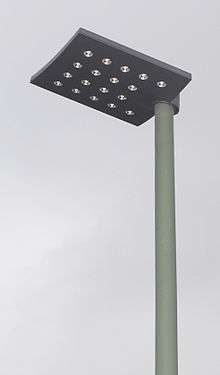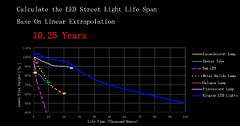LED street light
 LED street light in United Kingdom | |
| Type | LED, Street Light |
|---|---|
| First production |
March 2006, in Europe or South America 2010 North America |
An LED street light (also referred to as LED road lighting) is an integrated light-emitting diode (LED) light fixture that is used for street lighting.
Design and style

An LED street light is an integrated light that uses light emitting diodes (LED) as its light source. These are considered integrated lights because, in most cases, the luminaire and the fixture are not separate parts (except LEDGine-based luminaires). New in manufacturing, the LED light cluster is sealed on a panel and then assembled to the LED panel with a heat sink to become an integrated lighting fixture.
Different designs have been created that incorporate various types of LEDs into a light fixture. The current trend is to use high power 1 watt LEDs. However, some companies use low power LEDs in their products, including several low power LEDs packed together to perform the same purpose as a single high power LED. The shape of the LED street light depends on several factors, including LED configuration, the heat sink used with the LEDs and aesthetic design preference.
Heat sinks for LED street lights are similar in design to heat sinks used to cool other electronics such as computers. Heat sinks tend to have as many grooves as possible to facilitate the flow of hot air away from the LEDs. The area of heat exchange directly affects the lifespan of the LED street light.
The lifespan of an LED street light is determined by its light output compared to its original design specification. Once its brightness decreases by 30 percent, an LED street light is considered to be at the end of its life.
Most LED street lights have a lens on the LED panel, which is designed to cast its light in a rectangular pattern, an advantage compared to traditional street lights, which typically have a reflector on the back side of a high-pressure sodium lamp. In this case, much of the luminance of the light is lost and produces light pollution in the air and surrounding environment. Such street lights can also cause glare for drivers and pedestrians.
A drawback of LED focus panels is that most light is directed to the road, and less light to the footpaths and other areas. This can be addressed by the use of specialized lens design and adjustable mounting spigots.
Energy efficiency
The primary appeal of LED street lighting is energy efficiency compared to conventional street lighting fixture technologies such as high pressure sodium (HPS) and metal halide (MH). Research continues to improve the efficiency of newer models of LED street lights.
An LED street light based on a 901-milliwatt output LED can normally produce the same amount of (or higher) luminance as a traditional light, but requires only half of the power consumption. LED lighting does not typically fail, but instead decreases in output until it needs to be replaced.[1] It is estimated that installation of energy efficient street lighting in the 10 largest metropolitan areas in the U.S. could reduce annual carbon dioxide emissions by 1.2 million metric tons, the equivalent of taking 212,000 vehicles off the road, and save at least $90 million annually in electricity costs. [2][3]
As the LED lighting fixtures normally produce less illumination[4] it is very crucial to have a well distributed illumination pattern in order to do the same job as higher lumen conventional fixtures. So a good design of LED street lights is to point different LEDs in one fixture to different target points.
Health concerns about LED streetlights
- Exposure to the light of white LED bulbs suppresses melatonin by up to five times more than exposure to the light of pressure sodium bulbs.[5] The fact that white light, emitting at wavelengths of 400-500 nanometers suppresses the production of melatonin produced by the pineal gland is known. The effect is disruption of a human being’s biological clock resulting in poor sleeping and rest periods.[6]
- Research at the University of Madrid Complutense University[7] has claimed that long term exposure to LED Street-lighting can cause irreparable harm to the retina of the human eye. The Madrid study said this was caused by the high level of radiation in the’’blue band’’[8][9]
- Artificial night-time lighting has various effects on humans (not to mention wildlife) and exposure to optical radiation affects human physiology and behavior, both directly and indirectly. Many areas are not well understood, and a position statement from the Illumination Engineering Society (IES) emphasizes mainly the need for further research.[10]
- There is a main risk from glare. A French Government report published in 2013 agreed that a luminance level higher than 10,000 cd/m2 causes visual discomfort whatever the position of the lighting unit in the field of vision. As the emission surfaces of LEDs are highly concentrated point sources, the luminance of each individual source can be 1000 times higher than the discomfort level. The level of direct radiation from this type of source can therefore easily exceed the level of visual discomfort[11]
Advantages of LED street lights
- Low energy consumption: Many LED lighting retrofits have been claimed to dramatically reduce energy use, but in actual case studies lower energy use is limited and tied to reduced illumination levels[12]
- Long and predictable lifetime: The projected lifetime of LED street lights is usually 10 to 15 years, two to four times the life of currently prevalent HPS. (LEDs themselves do not generally fail or "burn out" in a way comparable to other technologies, and barring catastrophic failure of other mechanical or electronic components of the LED fixture, lifetimes are typically set by a decrease in luminous output of 30%. But the functional lifetime of an LED fixture is limited by the weakest link; associated drive electronics are typically projected to last about 50,000 hrs. It is important to understand that no LED streetlighting products have been in service long enough to confirm the projections). If realized in practice, the less frequent need to service or replace LEDs will mean lower maintenance cost.
- More accurate color rendering: The color rendering index is the ability of a light source to correctly reproduce the colors of the objects in comparison to an ideal light source. Improved color rendering makes it easier for drivers to recognize objects.
- Quick turn on and off: Unlike fluorescent and high-intensity discharge (HID) lamps, such as mercury vapor, metal halide, and sodium vapor lamps, which take time to heat up once switched on, LEDs come on with full brightness instantly.
- Immediate restart: Unlike mercury vapor, metal halide and sodium vapor lamps (commonly used in street lighting), LEDs do not have a problem restarting immediately (hot ignition) following a brief power failure or inadvertent turn off.
- RoHS compliance: LEDs don't contain mercury or lead, and don't release poisonous gases if damaged.
- Less attractive to nocturnal insects: Nocturnal insects are attracted to ultraviolet light emitted by many conventional light sources.
- Optically efficient lighting equipment: Other types of street lights use a reflector to capture the light emitted upwards from the lamp. Even under the best of conditions, the reflector absorbs some of the light. Also for fluorescent lamps and other lamps with phosphor coated bulbs, the bulb itself absorbs some of the light directed back down by the reflector. The glass cover, called a refractor, helps project the light down on the street in a desired pattern but some light is wasted by being directed up to the sky (light pollution). LED lamp assemblies (panels) can send light in the desired directions without a reflector.
- Reduced glare: Directing the light downward onto the roadway reduces the amount of light that is directed into driver's eyes.
- Higher light output even at low temperatures: While fluorescent lights are comparably energy efficient, on average they tend to have lesser light output at winter temperatures.
Disadvantages of LED street lights
- Many people dislike the ambiance produced by LEDs with color temperatures of 4000K or higher, often calling it zombie or prison lighting.[13][14]
- There is a main risk from glare. A French Government report published in 2013 agreed that a luminance level higher than 10,000 cd/m2 causes visual discomfort whatever the position of the lighting unit in the field of vision.[11]
- The initial cost of LED street lighting is high and as a consequence it takes several years for the savings on energy to pay for that. The high cost derives in part from the material used since LEDs are often made on sapphire or other expensive substrates.[15]
- By the Purkinje effect, the dark-adapted human eye is very sensitive to blue and green light that LED street lights emit in large amounts, as compared to the high-pressure sodium lights that are typically being replaced.[16][17][18] This magnifies the effect of light pollution - particularly sky glow.
- The major increase in the blue and green content of artificial sky glow arising from widespread LED lighting is likely to increase impacts on bird migration and other nocturnal animal behaviours.[19]
- There is progressive wear of layers of phosphor in white LEDs. The change in color slowly moves devices from one photobiological risk group to a higher one.[11]
References
- 1 2 Street lighting technology comparison
- ↑ Grow, Robert T., Energy Efficient Streetlights - Potentials for Reducing Greater Washington's Carbon Footprint, March, 2008
- ↑ http://blog.mlive.com/michigan/2008/04/study_new_street_light_technol.html
- ↑ "LED Street Light". www.northernlights-direct.co.uk. Retrieved 4 October 2016.
- ↑ University of Haifa study by Professor Abraham Haim, director of the Israeli Center for Interdisciplinary Studies in Chronobiology Sept 2012
- ↑ "Exposure to 'white' light LEDs appears to suppress body's production of melatonin more than certain other lights, research suggests". www.sciencedaily.com. Retrieved 4 October 2016.
- ↑ Dr. Celia Sanchez Ramos, The Effect of Light-Emitting Diode (LED) on eyesight, Complutense University Madrid , 2013
- ↑ "LED lights can damage your eyes". The Hindu. 15 May 2013. Retrieved 4 October 2016.
- ↑ "Do White LEDs Disrupt our Biological Clocks?". www.insidescience.org. 19 June 2012. Retrieved 4 October 2016.
- ↑ http://ledsmagazine.com/news/7/11/13
- 1 2 3 ANSES, the French Agency for Food, Environmental and Occupational Health & Safety, September 2013
- ↑ Kostic, A.M. et al., Light-emitting diodes in street and roadway lighting – a case study involving mesopic effects, Lighting Research and Technology 45:217, 2013, doi: 10.1177/1477153512440771
- ↑ Benya, James. "Nights in Davis". Retrieved 21 April 2016.
- ↑ Chaban, Matt. "LED Streetlights in Brooklyn Are Saving Energy but Exhausting Residents". New York Times. Retrieved 21 April 2016.
- ↑ "How LED Streetlights Work". science.howstuffworks.com. 22 June 2009. Retrieved 4 October 2016.
- ↑ Limiting the impact of light pollution on human health, environment and stellar visibility, Journal of Environmental Management, Volume 92, Issue 10, October 2011, Pages 2714-2722 by Fabio Falchi, Pierantonio Cinzano, Christopher D. Elvidge, David M. Keith, Abraham Haim
- ↑ Luginbuhl, C.B. et al., The impact of light source spectral power distribution on sky glow. J. of Quantitative Spectroscopy and Radiative Transfer, 2014, v. 139; p. 21., doi:10.1016/j.jqsrt.2013.12.004
- ↑ Aubé, M. et al., Evaluating Potential Spectral Impacts of Various Artificial Lights on Melatonin Suppression, Photosynthesis, and Star Visibility. PLOS ONE, 2013, DOI: 10.1371/journal.pone.0067798
- ↑ http://lighting.com/light-pollution-wildlife.htm. Turning Night Into Day: Light Pollution’s Impacts on Wildlife
External links
- U.S. Department of Energy reports on municipal LED lighting pilot projects: Solid-State Lighting GATEWAY Demonstration Results
